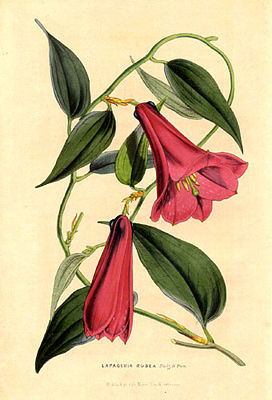Philesiaceae
| Philesiaceae | ||||||||||||
|---|---|---|---|---|---|---|---|---|---|---|---|---|

Chilean wax bell ( Lapageria rosea ) |
||||||||||||
| Systematics | ||||||||||||
|
||||||||||||
| Scientific name | ||||||||||||
| Philesiaceae | ||||||||||||
| Dumort. |
The Philesiaceae are a family of plants in the order of the lily-like (Liliales). The only two species are common in the southern part of Chile in the temperate rainforests of the Chilean west coast, in the " Valdivian forests ".
description

Vegetative characteristics
They are woody plants: clockwise lianas ( Lapageria ) or independently upright bushes ( Philesia ). The alternate leaves are stalked to sessile. The coarse to leathery leaf blades are simply linear, lanceolate or ovate with a leaf veins that are relatively untypical for monocotyledons . The leaf margin is smooth. The stomata are anomocytic.
Generative characteristics
The flowers are individually terminal on short shoots or in the leaf axils. There are support and cover sheets. The showy, bell-like flowers are hermaphrodite, radial symmetry and threefold. There are two circles, each with three identical, free bloom cladding sheets ( perigone ). There are two circles, each with three fertile stamens , which do not grow together with the bloom and are also free from one another. The pollen grains have no apertures. The nectar secretion takes place at the base of the bracts. Three carpels have become a top permanent, single-chamber ovary grown. The ten to one hundred anatropic, bitegmic, crassinucellate ovules sit in parietal placentation . There is a stylus available.
There are berries formed. The seeds contain abundant oily endosperm and a differentiated, straight embryo. The thin seed coat (testa) does not contain any phytomelan.
Systematics and distribution
Both species are native to the southern part of Chile , in the temperate rainforests of the Chilean west coast, in the " Valdivian forests ".
There are only two monotypical genera , i.e. only two species in the Philesiaceae family:
-
Lapageria
Ruiz & Pav .:
-
Chilean wax bell ( Lapageria rosea Ruiz & Pav. ): The national flower of Chile thrives in the southern part of Chile in the temperate rainforests of the Chilean west coast, in the Valdivian forests, with the two varieties:
- Lapageria rosea var. Rosea
- Lapageria rosea var. Albiflora Hook.
-
Chilean wax bell ( Lapageria rosea Ruiz & Pav. ): The national flower of Chile thrives in the southern part of Chile in the temperate rainforests of the Chilean west coast, in the Valdivian forests, with the two varieties:
-
Philesia Comm. ex Juss. :
- Philesia magellanica J.F. Gmel. ( Syn .: Philesia buxifolia Willd. ): It thrives in the southern part of Chile in the regions XII = Magallanes y de la Antártica Chilena to XIV = Los Ríos , in the temperate rainforests of the Chilean west coast, in the Valdivian forests.
swell
- Description of the family of Philesiaceae in APWebsite. (Section description and systematics)
- Description of the Philesiaceae family at DELTA. (Section description)
Individual evidence
- ^ Philesiaceae in the Germplasm Resources Information Network (GRIN), USDA , ARS , National Genetic Resources Program. National Germplasm Resources Laboratory, Beltsville, Maryland. Retrieved September 25, 2014.